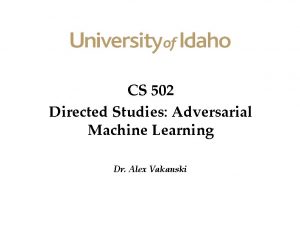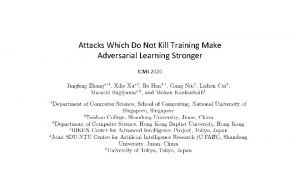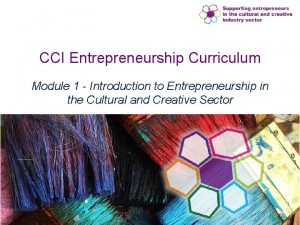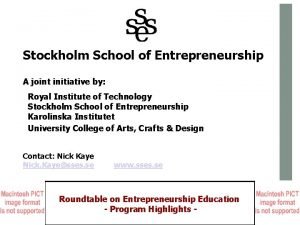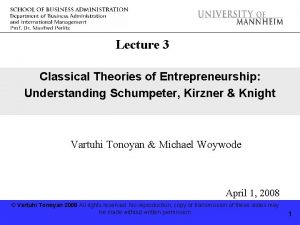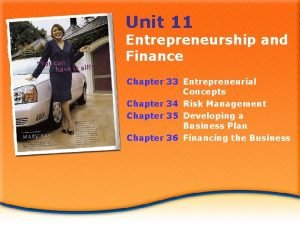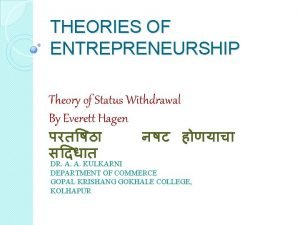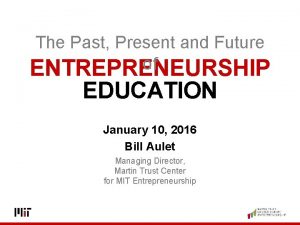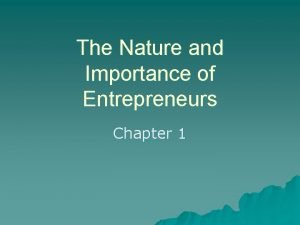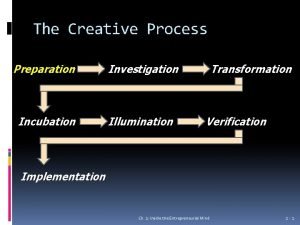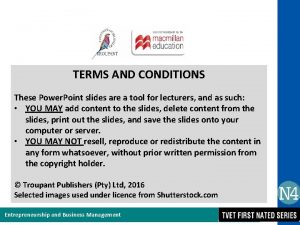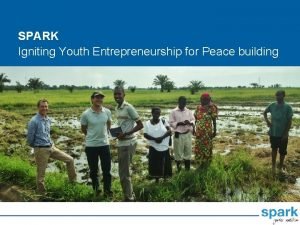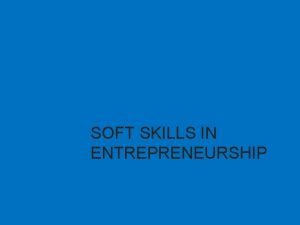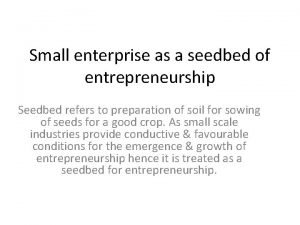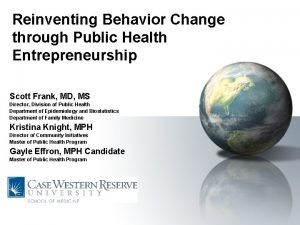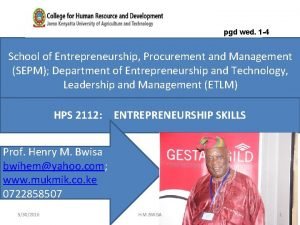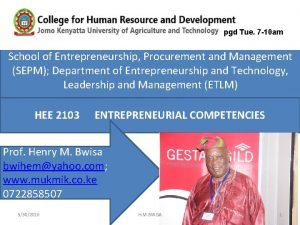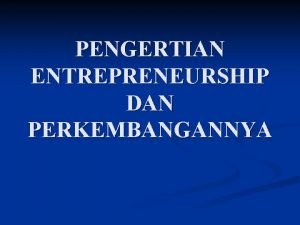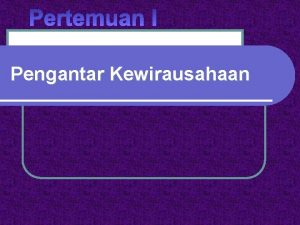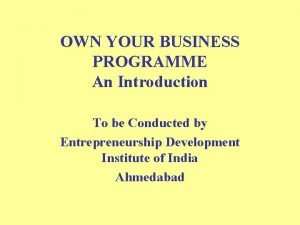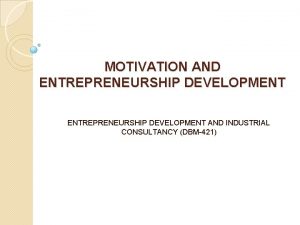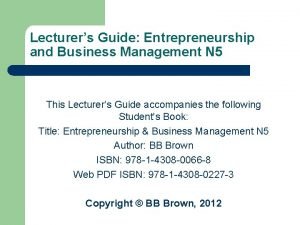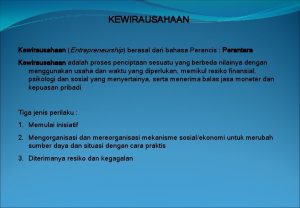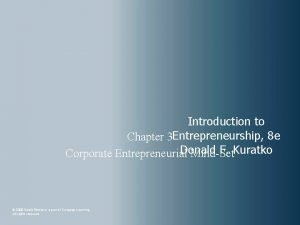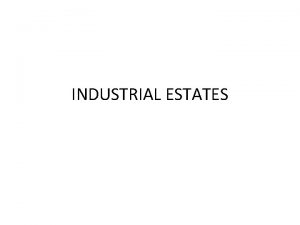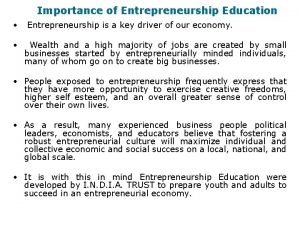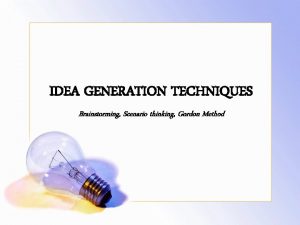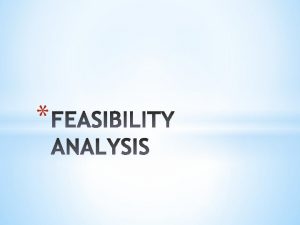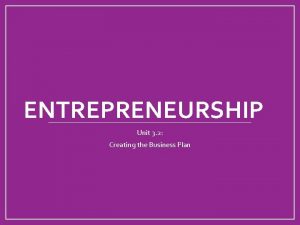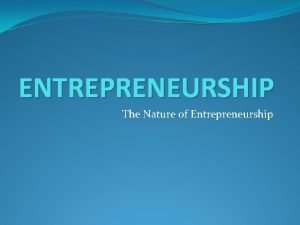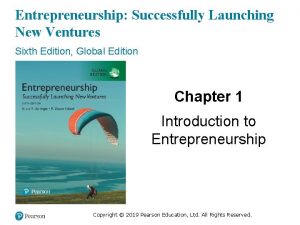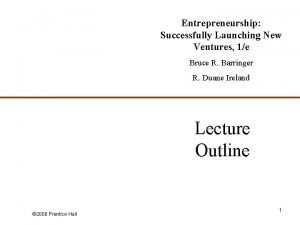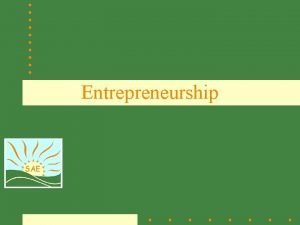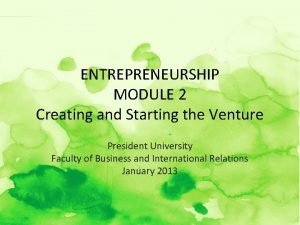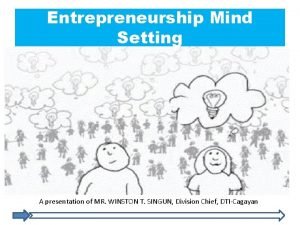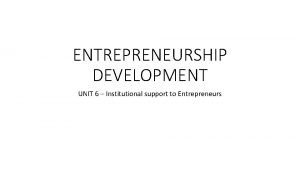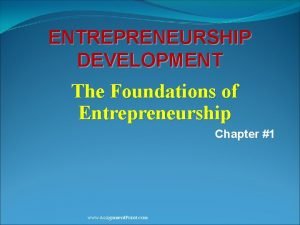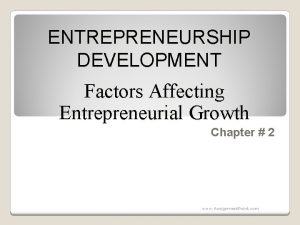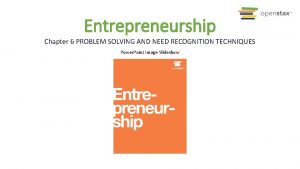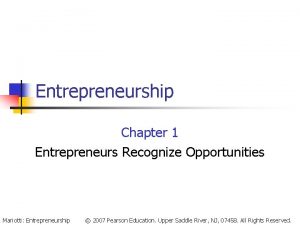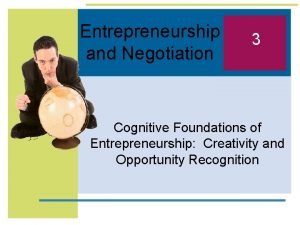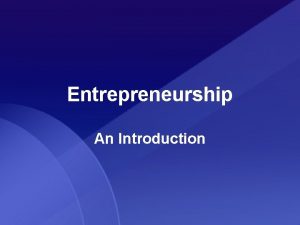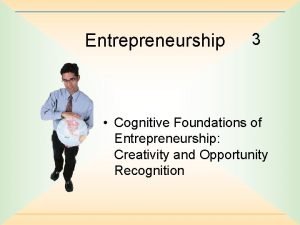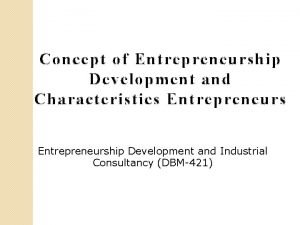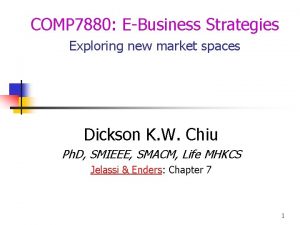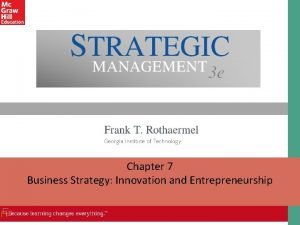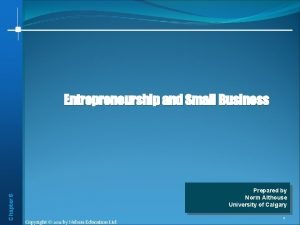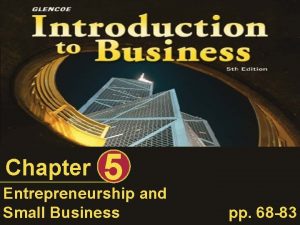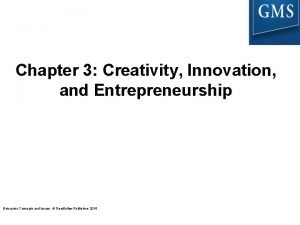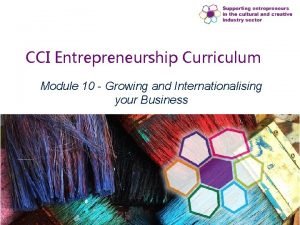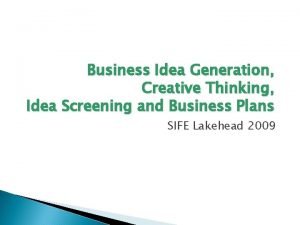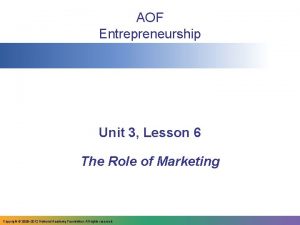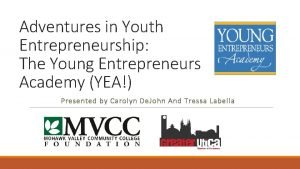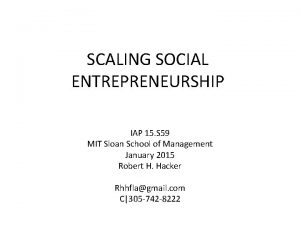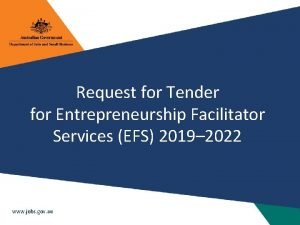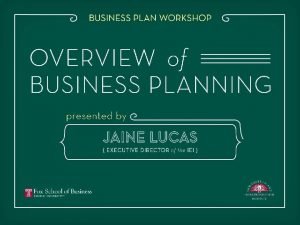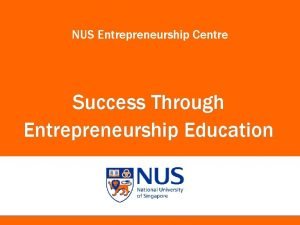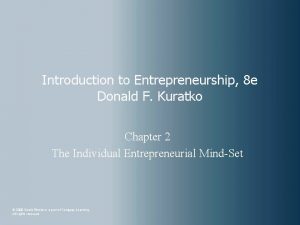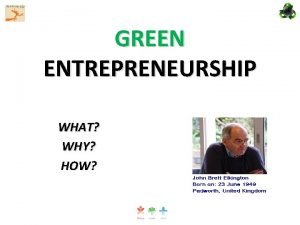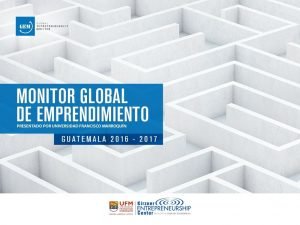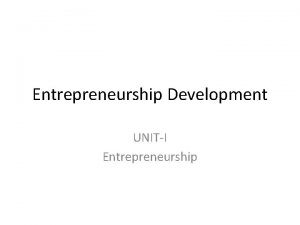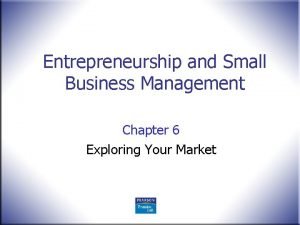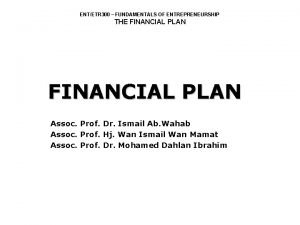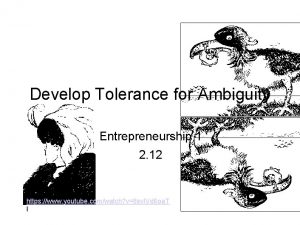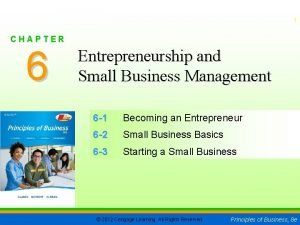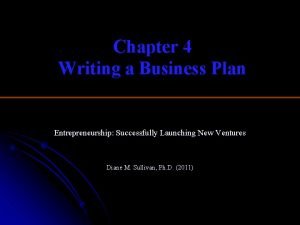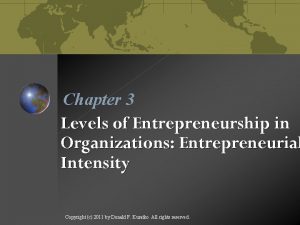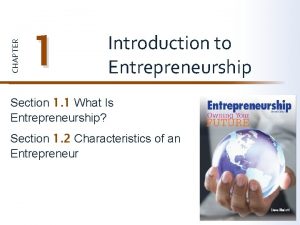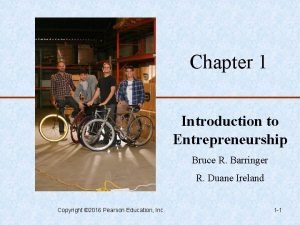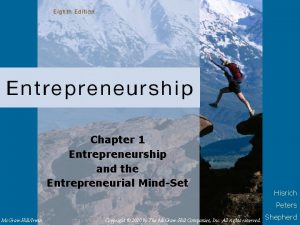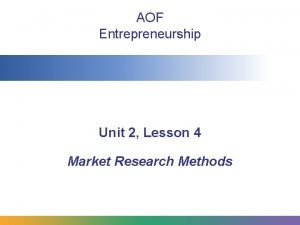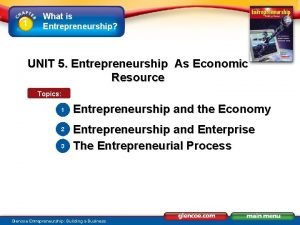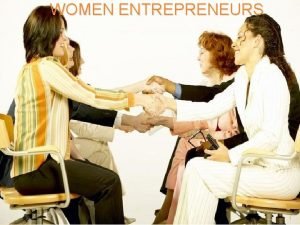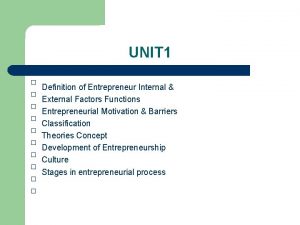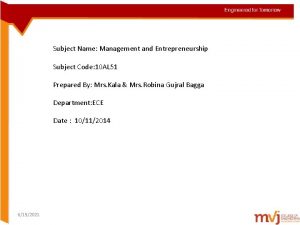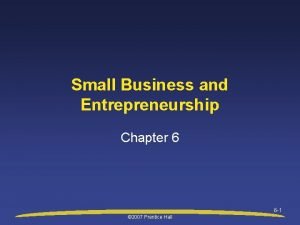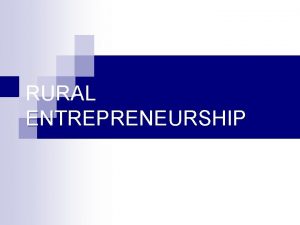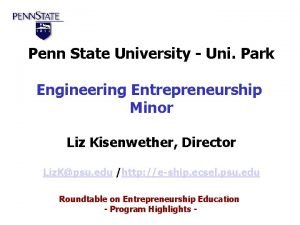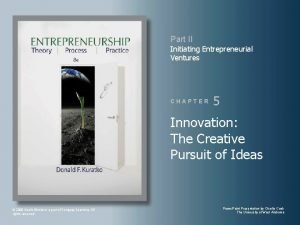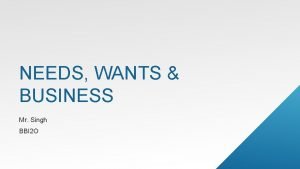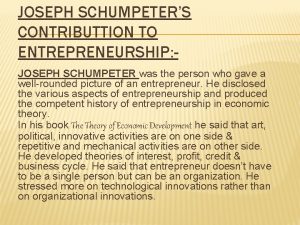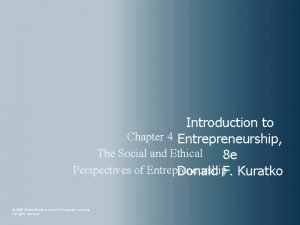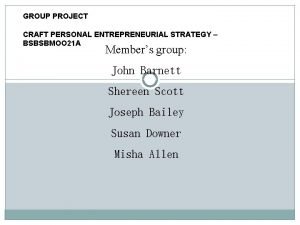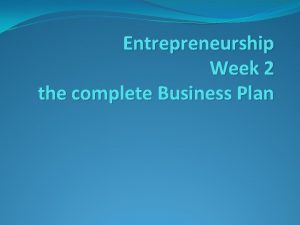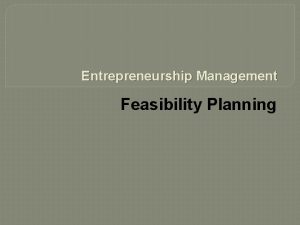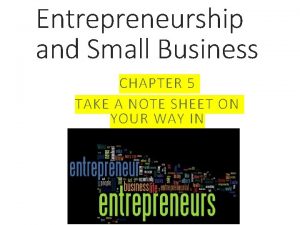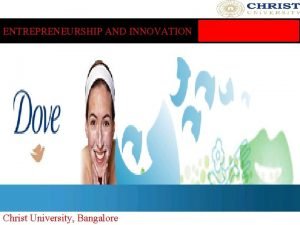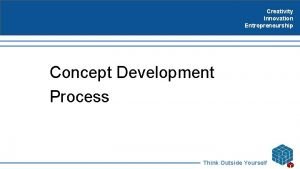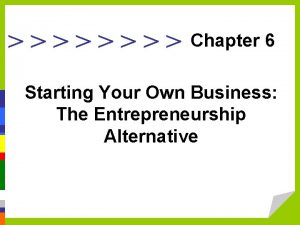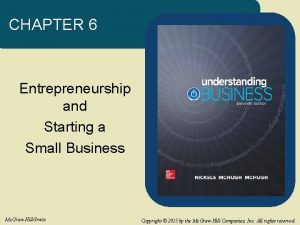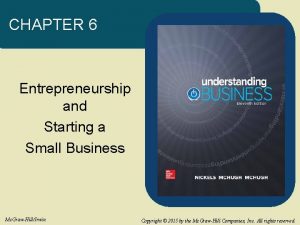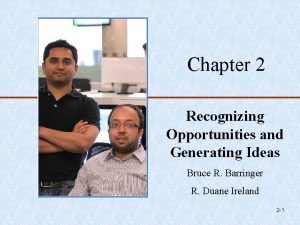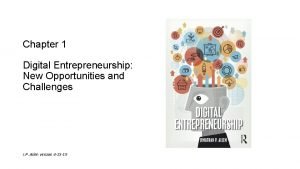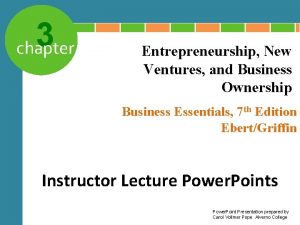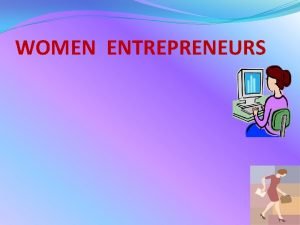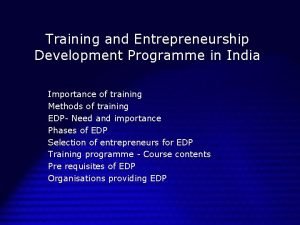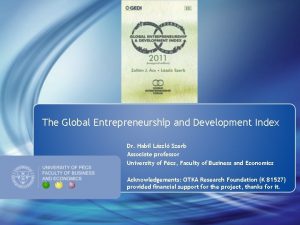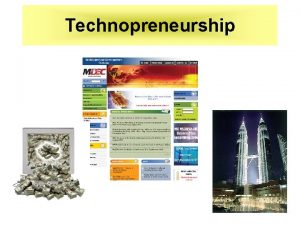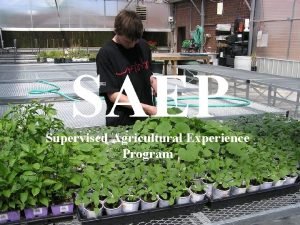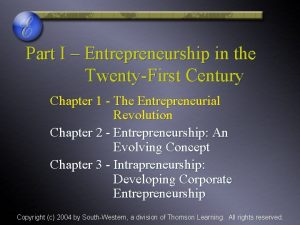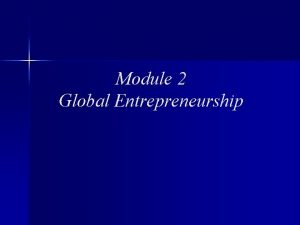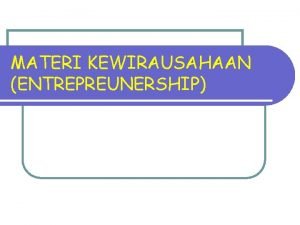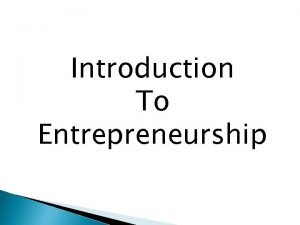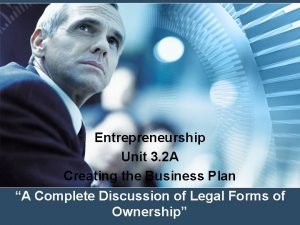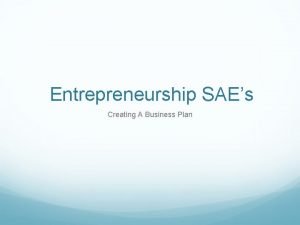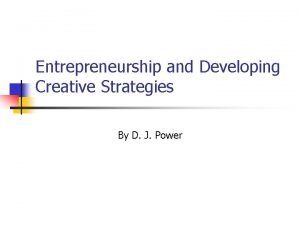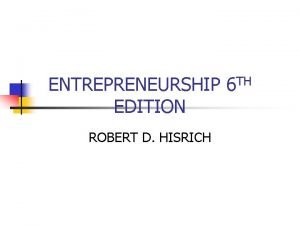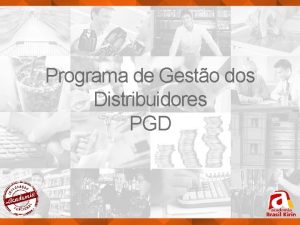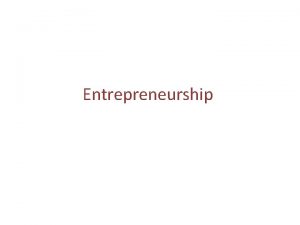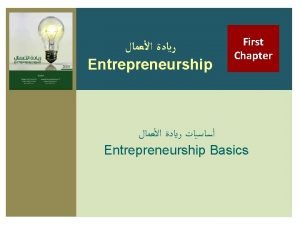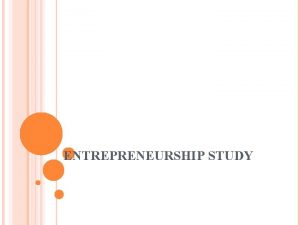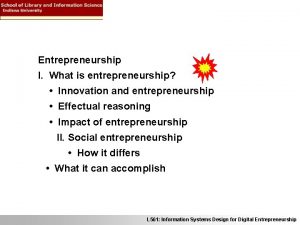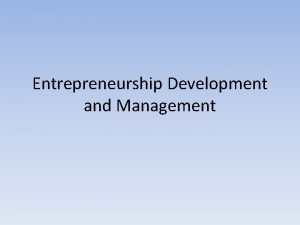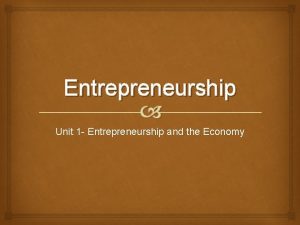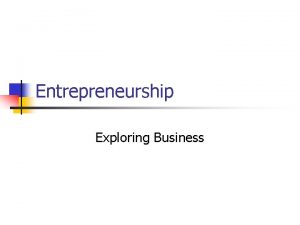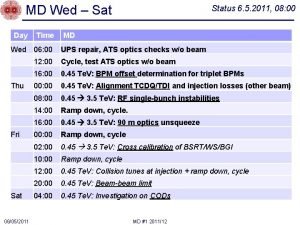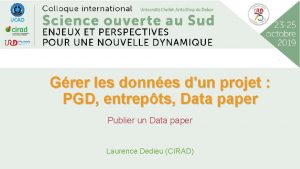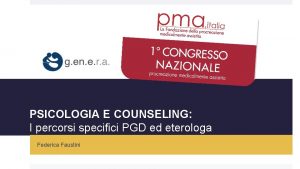pgd WED 4 7 pm School of Entrepreneurship









































































































































- Slides: 137

pgd WED 4 -7 pm School of Entrepreneurship, Procurement and Management (SEPM); Department of Entrepreneurship and Technology, Leadership and Management (ETLM) HEIT 2105 INTRODUCTION TO TECHNOLOGY AND INNOVATION Prof. Henry M. Bwisa bwihem@yahoo. com; www. mukmik. co. ke 0722858507 5/30/2016 H. M. BWISA 1

Disclaimer • Some materials used in compiling these notes were obtained from a number of internet sources. This was done in full recognition of copyright and plagiarism rules and regulations and the aspects which allow for fair use including teaching purposes.

My delivery philosophy 1946 Confucius 450 BC David Kolb - 1984 5/30/2016 Benjamin Bloom 1956 H. M. BWISA 3

Teaching method and instructional materials INSTRUCTIONAL METHODS • Lectures and readings • Group and individual assignments and discussions • Field studies and observations • Case studies • INSTRUCTIONAL MATERIALS • Boards, lecture notes, reading materials, case studies/successful stories, computer, and projector. 5/30/2016 H. M. BWISA 4

COURSE STRUCTURE ACTIVITY START-END DURATION % OF TOTAL TIME CLASSROOM LECTURES WEEK 1 -4 4 WEEKS 27 FIELD WORK WEEK 5 - 11 7 WEEKS 47 CLASS PRESENTATIONS WEEK 12 -14 3 WEEKS 20 EXAMINATION WEEK 15 1 WEEK 06 TOTALS WEEK 1 -15 15 WEEKS 100 CHANGES IN SEMESTER DURATION WILL BE ACCOMMODATED ON PRO RATA BASIS 5/30/2016 H. M. BWISA 5

Unit course assessment • ASSESSMENT MODE MARKS • • • Class participation 10% Group presentations 20% Continuous assessment tests 20% End of semester project 50% TOTAL 100% 5/30/2016 H. M. BWISA 6

Course evaluations • The course will be evaluated via class participation, group presentations and an end of semester project as an examination • CATs will comprise of regular classroom queries and class presentations • End of semester project will be a practical assignment that addresses real issues in the Kenyan environment and calls for the application of theoretical knowledge gained from this unit in particular and other course units in general 5/30/2016 H. M. BWISA 7

The philosophy and approach of the course The course will be conducted on Confucius’ philosophy of: • I hear and I forget • I see and I remember • I do and I understand 5/30/2016 H. M. BWISA 8

References 1) MAKE COMPREHENSIVE USE OF THE INTERNET ENGINES 2) For general aspects visit www. professorbwisa. com; www. mukmik. com 5/30/2016 H. M. BWISA 9

CAT AND EXAMINATION ASSIGNMENTS CAT • • In a group of not more than three: 1. Select a given product/service/technology/problem etc that you think requires an innovation 2. apply the scamper technique to it. 3. design the innovation for presentation in class Your presentation should cover the following aspect: a) name of the innovation b) problem it addresses c) aspect(s) of scamper involved EXAMINATION Brand yourself as an entrepreneur, identify a business you want to start and present its canvas.

Personal branding

Your Business Canvas template

Guide to filling business canvas My business will be……………… Customer Segments: Who will be your customers? Value Propositions: What value will you give the customers with your business? Channels: How will you reach the customers? Customer Relationships: How will you be interacting with the customers? Revenue Streams: How will the business earn money? Key Activities: What uniquely things will you do or offer? Key Resources: What resources will you need? Key Partnerships: What partnerships might/will you require? Cost Structure: What will be your key areas for expenditure?

• • • RULES FOR THE END OF SEMESTER EXAMINATION YOU MAY WORK IN GROUPS BUT THE END PROJECT MUST BE INDIVIDUAL PROJECTS FOUND TO BE SIMILAR WILL BE CONSIDERED AN EXAMINATION IRREGULARITY (CHEATING) AND MARKED OUT OF ZERO PERCENT A SOFT COPY OF THE PROJECT MUST BE SUBMITTED TO bwihem@yahoo. com LATEST A DAY BEFORE THE OFFICIAL UNIVERSITY EXAMINATION DATE A HARD COPY MUST BE SUBMITTED (NO PRESENTATIONS) IN PERSON ON THE OFFICIAL UNIVERSITY EXAMINATION DAY EVERY STUDENT WILL SIGN THE EXAMINATION ROLL CALL ON SUBMISSION OF THE HARD COPY FAILURE TO SUBMIT BY THE SAID DEADLINES WILL BE DEEMED AN EXAMINATION FAILURE I. E. A ZERO MARK WILL BE AWARDED

About innovation • Wikipedia defines innovation as a "new idea, device, or method“. It is also viewed as the application of better solutions that meet new requirements, unarticulated needs, or existing market needs. We are advised that this is accomplished through more-effective products, processes, services, technologies, or business models that are readily available to markets, governments and society. Some scholars view the term "innovation“ as something original and more effective and, as a consequence, new, that "breaks into" the market or society. It is related to, but not the same as, invention and/or discovery • Innovation is a result of a process that brings together various novel ideas in a way that they affect society. It is the process of implementing new ideas to create value. This may mean creating a new service, system, or process, or enhancing existing ones. Innovation can also take the form of discontinuing an inefficient or out-ofdate service, system, or process.

Peter F. Drucker, in his book Innovation and Entrepreneurship: Practice and Principles says…. . • “And it is change that always provides the opportunity for the new and different. Systematic innovation therefore consists in the purposeful and organized search for changes, and in the systematic analysis of the opportunities such changes might offer for economic or social innovation. ” He goes on to say that innovation defines entrepreneur and entrepreneurship - the entrepreneur always searches for change, responds to it, and exploits it as an opportunity. ”

Peter Drucker continues to teach us that. . . • “ An innovation, to be effective, has to be simple and it has to be focused. It should do only one thing, otherwise, it confuses. If it is not simple, it won’t work. Everything new runs into trouble; if complicated, it cannot be repaired or fixed. All effective innovations are breathtakingly simple. Indeed, the greatest praise an innovation can receive is for people to say: ‘This is obvious. Why didn’t I think of it? ’ Even the innovation that creates new uses and new markets should be directed toward a specific, clear, designed application. It should be focused on a specific need that it satisfies, on a specific end result that it produces. ”

The same Peter Drucker invokes others in his thoughts. . • • “Entrepreneurship rests on a theory of economy and society. The theory sees change as normal and indeed as healthy. And it sees the major task in society - and especially in the economy - as doing something different rather than doing better what is already being done. That is basically what J. B. Say, two hundred years ago, meant when he coined the term entrepreneur. It was intended as a manifesto and as a declaration of dissent: the entrepreneur upsets and disorganizes. As Joseph Schumpeter formulated it, his task is "creative destruction. ” J. B. Say was a French economist who, as early as 1800 said that the entrepreneur shifts resources out of an area of lower and into an area of higher productivity and greater yield. This can be simply translated that entrepreneurs create value. Joseph Schumpeter, Austrian economist, 1911 said that entrepreneurship is creative destruction. He added that dynamic disequilibrium brought on by the innovating entrepreneur, rather than equilibrium and optimization, is the norm of a healthy economy and the central reality of economic theory and practice. Creative destruction is a process through which something new and better brings about the demise of whatever existed before it.

Peter Drucker differentiates entrepreneurship from business • “The husband wife who open another delicatessen store or another Mexican restaurant in the American suburb surely take a risk. But are they entrepreneurs? All they do is what has been done many times before. They gamble on the increasing popularity of eating out in their area, but create neither a new satisfaction nor new consumer demand. Seen under this perspective they are surely not entrepreneurs even though theirs is a new venture. Mc. Donald’s, however, was entrepreneurship. It did not invent anything, to be sure. Its final product was what any decent American restaurant had produced years ago. But by applying management concepts and management techniques (asking, What is “value” to the customer? ), standardizing the “product, ” designing process and tools, and by basing training on the analysis of the work to be done and then setting the standards it required, Mc. Donald’s both drastically upgraded the yield from resources, and created a new market and a new customer. This is entrepreneurship. ” we can say that all entrepreneurs are business people but not all business people are entrepreneurs Business people Entrepreneurs are a special breed of business people. There are business people who do not belong to the circle of entrepreneurs Entrepreneurs

SUCCESSFUL ENTREPRENEURS VISUALIZE SUCCESS ENTREPRENEURIALLY LETTER MEANING REMARKS S SET YOUR GOAL Entrepreneurs set SMART goals. They believe that if you do not know where you are going then you either go nowhere or any road will led you there U UNDERSTAND THE OBSTACLES Entrepreneurs belief that a slip is not a fall. They see opportunities in obstacles C CREATE POSITIVE MENTAL PICTURE Entrepreneurs always see the glass as half-full never halfway or half empty; they are realistically optimistic C CLEAR YOUR MIND OF SELF DOUBT Entrepreneurs are self-confident E EMBRACE THE CHALLENGE Entrepreneurs take calculated risks to address the challenges they face S STAY ON TRACK Entrepreneurs are focussed. They keep the eye on the ball S SHOW THE WORLD YOU CAN DO IT Entrepreneurs think globally even if they may act locally

Entrepreneurs convert from poor to rich P PASSING R REAP O O R OVER I C H INCOMES OPPORTUNITIES REPEATEDLY CONSISTENTLY & HONESTLY

Bwisa’s personal entrepreneurial characteristics (PECs) The word /letter The characteristic E Envisioning (goal setting) N Novelty minded (innovativeness, creativity) T Tolerant (perseverance) R Responsibility E Enterprising (resourceful, industriousness) P Passion R Risk-taking E Energetic N Networking E Efficient (and effective) U Unstoppable R Realistic S Self-confidence

SCAMPER METHOD TOOL FOR MORE GREAT IDEAS

SCAMPER – Tool for Innovation • SCAMPER is attributed to Bob Eberle, author of books about creativity for children aimed at teachers. • SCAMPER is a great way to stimulate innovation or to modify existing products or ideas. To use it, you can apply any of 7 different actions to your ideas. 07/12/2020

SCAMPER – Tool for Innovation SCAMPER stands for • S Substitute (components, materials, people) • C Combine (mix, combine with other assemblies or services, integrate) • A Adapt (alter, change function, use part of another element) • M Modify/Magnify/Minify (increase or reduce in scale, change shape, modify attributes) • P Put to other uses • E Eliminate (remove elements, simplify, reduce to core functionality) • R Rearrange/Reverse (turn inside out or upside down) 07/12/2020

SCAMPER – Tool for Innovation 07/12/2020

SCAMPER – Tool for Innovation Substitute white board for black board 07/12/2020

SCAMPER – Tool for Innovation Substitute Bamboo for metal 07/12/2020

SCAMPER – Tool for Innovation Substitute Solar power for kerosene 07/12/2020

SCAMPER – Tool for Innovation Substitute aluminium for steel 07/12/2020

SCAMPER • Combine your ideas (i. e. spoon + fork = spork) 12/7/2020 H. M. Bwisa (2012) 31

SCAMPER – Tool for Innovation Combine – spoon + fork = spork 07/12/2020

SCAMPER – Tool for Innovation Combine shampoo+ oil 07/12/2020

SCAMPER – Tool for Innovation Combine CNG + electric 07/12/2020

SCAMPER – Tool for Innovation Combine car + scooter 07/12/2020

SCAMPER – Tool for Innovation Combine motorcycle + kneeling chair 07/12/2020 http: //www. dechavesgarage. com/design/e 06. php

SCAMPER – Tool for Innovation Adapt – road bike into a mountain bike 07/12/2020

SCAMPER – Tool for Innovation Adapt – bicycle as a farm tiller and seeder 07/12/2020

SCAMPER – Tool for Innovation Adapt van as a mobile office 07/12/2020 Volkswagenpedia. org

SCAMPER – Tool for Innovation Adapt computer fan mimics owl’s wing http: //www. technospot. net/blogs/technologies-inspired-by-nature/ 07/12/2020

SCAMPER – Tool for Innovation Adapt robotic arm mimics an elephant’s trunk 07/12/2020 http: //www. azorobotics. com/Details. asp? news. ID=469

SCAMPER – Tool for Innovation Magnify • Stretch Limousine Minify Desktop into a Notebook Modify (which can be either of the above) 07/12/2020

SCAMPER • Modify (i. e. SUV with retractable roof • Magnify (i. e. stretch Hummer) • Minify (i. e. desktop into a laptop) 12/7/2020 H. M. Bwisa (2012) 43

SCAMPER – Tool for Innovation Put to other uses – car tyres used as swings 07/12/2020

SCAMPER – Tool for Innovation Put to other use Mirror - rear view 07/12/2020

SCAMPER – Tool for Innovation Put to other use Bottle as a display case 07/12/2020

SCAMPER – Tool for Innovation Put to other use CD Drive as a clock Source: http: //www. ecofriend. org/entry/eco-friendly-desktop-clock-with-a-cd/ 07/12/2020

SCAMPER – Tool for Innovation Put to other use Car exterior as solar panels Eve Concept Vehicle 07/12/2020

SCAMPER – Tool for Innovation Eliminate – cordless telephone 07/12/2020

SCAMPER – Tool for Innovation Eliminate reverse gear 360 deg rotating cabin Nissan Pivo 2 07/12/2020

SCAMPER – Tool for Innovation Reverse/Rearrange • motor run backwards = a generator 07/12/2020

SCAMPER – Tool for Innovation Reverse/Rearrange 07/12/2020 • exchange the position of the digital display and the buttons • buttons easier to press as they are larger • angled time display is easier to read

SCAMPER – Tool for Innovation Reverse/Rearrange 07/12/2020 • reverse door peep-hole • see into a room from the outside

Nano Design - SCAMPER 2 -Cylinder Engine Adapt No Air-bag / AC / Power Windows Eliminate Adhesive for Welding Substitute Plastic for Metal Substitute 07/12/2020 Size just 10 ft X 5 ft Minimize

SCAMPER – Tool for Innovation Peacock Team: Seat Belt Improvement Elephant Team: Bottle Holder Improvment 07/12/2020

SCAMPER – Tool for Innovation Peacock Team: Seat Belt Improvement 07/12/2020

SCAMPER – Tool for Innovation Elephant Team: Bottle Holder Improvment 07/12/2020

3 SCAMPER

• Lets look at the normal office stationary

(S) Substitute something – elements, information, individuals. 12/7/2020 H. M. Bwisa (2012) 60

(C) Combine several parts of your problem to get something different and achieve synergy 12/7/2020 H. M. Bwisa (2012) 61

(A) Adapt or change certain components of your issue, alter its function, use part of another component 12/7/2020 H. M. Bwisa (2012) 62

(M) Modify or Magnify part of the problem, or approach it in an unordinary way 12/7/2020 H. M. Bwisa (2012) 63

(P) Put the issue to some other use. Come up with other ways to use your product or services. Ask yourself how you can solve your problem by reimplementing something from areas that have nothing to do with your current issue 12/7/2020 H. M. Bwisa (2012) 64

(R) Rearrange (or reverse). Think of what you might do if part of your problem/process/product was implemented in a different order or functioned in reverse. It helps you see your situation from different perspectives. 12/7/2020 H. M. Bwisa (2012) 65

12/7/2020 H. M. Bwisa (2012) 66

From the course syllabus • Introduction: Overview: What is technology and innovation? How does it relate to enterprise development? Importance of technological innovation for competitiveness, Knowledge, Creativity and Innovation, technology Institutions, governance and policy. Technology and Innovation Management, Technology Strategy: overview: Contexts and Tools of Technology Strategy, Technology Strategy in a Technology-specific Context, Technology Strategy in an Industry-Specific Context, Technology Strategy in a Firm-Specific Context; Main Functions of Technology and Innovation Management: Technology Sourcing, Technology Timing, Technology Utilization and Marketing; Key Implementation Aspects of Technology and Innovation Management: Overcoming Innovation Barriers, International Organization of Technology Management, National and international innovation systems, national technology and innovation stakeholders, Destination Innovations, new product development, collaboration, commercialisation, production and operations

course notes

What is technology? 12/7/2020 H. M. Bwisa (2012) 69

Technology and Innovation • Technology –“Knowledge of how to do things. ” –“The system by which a society satisfies its needs and desires. ” –“Capability that a firm needs to provide its customers the good and/or services the firm proposes to offer, now and in the future. ” 12/7/2020 H. M. Bwisa (2012) 70

What is Technology? What Counts as Technology? There are “classes” of technology: 1. Technology as Objects: Tools, machines, instruments, weapons, appliances - the physical devices of technical performance 2. Technology as Knowledge: The know-how behind technological innovation 3. Technology as Activities: What people do - their skills, methods, procedures, routines 4. Technology as a Process: Begins with a need and ends with a solution 5. Technology as a Socio-technical System: The manufacture and use of objects involving people and other objects in combination 12/7/2020 H. M. Bwisa (2012) 71

What is technology? TECHNOLOGY HARDWARE SOFTWARE SYSTEM-WARE physical embodiments e. g. tools, equipment skills to make hardware work infrastructure to make hardware work e. g. institutions, legal framework LIVE-WARE technical and managerial skills 12/7/2020 INNOVATION-WARE know how to improve, add value, innovate H. M. Bwisa (2012) 72

The nature of Technology: it has a number of characteristics 12/7/2020 H. M. Bwisa (2012) 73

1. It is Related to Science? Science is concerned with understanding how nature and the physical world work. Science is a process by which we try to understand how the natural and physical world works and how it came to be that way. • You see something happen, you ask why? • You want to make something happen, you ask how? • Science is a tool for answering why and how. 12/7/2020 H. M. Bwisa (2012) 74

2. It Involves Design: . The design process begins with the perception of a need, to formulation of a specification, to the generation of ideas and a final solution, and ends with an evaluation of the solution. For the term “design process, ” we can also read “problem-solving process”. The process begins with the identification and analysis of a problem or need and proceeds through a structured sequence in which information is researched and ideas explored and evaluated until the optimum solution to the problem or 12/7/2020 H. M. Bwisa (2012) 75

3. It Involves Making: The motivating factor behind all technological activity is the desire to fulfill a need. Making = devising: the act that results in something coming to be; "the devising of plans"; "the fashioning of pots and pans"; "the making of measurements. . . 12/7/2020 H. M. Bwisa (2012) 76

4. It is Multi-Dimensional: involves co-operation between different specialisms (e. g. between designer, production engineer and materials scientist) 12/7/2020 H. M. Bwisa (2012) 77

5. It Is Concerned With Values: Value decisions may be called for not only in relation to the specific design criteria (i. e. aesthetic, ergonomic and economic judgments, suitability for purpose and ease of manufacture) but also in relation to the rightness or wrongness of a particular solution in ethical terms. 12/7/2020 H. M. Bwisa (2012) 78

6. It is Socially Shaped/Shaping: Technological enterprises are determined by advances in knowledge, the identification of needs and by social interests. Thus technology is shaped by society, by consumer choice. True also technology shapes society - the technology of the motor car, for example, has shaped our environment and our whole way of life. 12/7/2020 H. M. Bwisa (2012) 79

• Innovation

What is innovation? • Innovation is the process and outcome of creating something new, which is also of value. • Innovation involves the whole process from opportunity identification, ideation or invention to development, prototyping, production marketing and sales, while entrepreneurship only needs to involve commercialization (Schumpeter).

• Innovation = Invention + exploitation (Ettlie) • A new way of doing things, which is commercialized. The process of innovation cannot be separated from a firm’s strategic and competetive context (Porter) • Adoption of ideas that are new to the adopting organization

What is innovation? • Today it is also said to involve the capacity to adapt quickly by adopting new innovations (products, processes, strategies, organization, etc) • Traditionally the focus has been on new products or processes, but recently new business models have come into focus, i. e. the way a firm delivers value and secures profits.

What is innovation? • Schumpeter argued that innovation comes about through new combinations made by an entrepreneur, resulting in – – – a new product, a new process, opening of new market, new way of organizing the business new sources of supply

Mechanisms of innovation • Novelty in product or service (offering something no one else does) • Novelty in process (offering it in a new way) • Complexity (offer something which others find difficult to master) • Timing (first mover advantage, fast follower) • Add/extend competetive factors (e. g. From price to quality or choice) • Robust design (contribute a platform on which other variations can build) • Reconfiguring the parts (building more effective business networks) • . . .

Dimensions of innovation Extent of change (radical—incremental) Modality of change (product—process) Complexity of change (component—architecture) Materiality of change (physical—intangible) Capabilities and change (enhances or destroys market/technological capabilties) • Relatedness of change (replaces a firm’s existing product or extends it) • Appropriability/Imitability (difficult or hard to hang on to) • Cycle of innovation (time between discontinuities) • • •

Drivers for innovation – Financial pressures to reduce costs, increase efficiency, do more with less, etc – Increased competition – Shorter product life cycles – Value migration – Stricter regulation – Industry and community needs for sustainable development – Increased demend for accountability – Demographic, social and maket changes – Rising customer expectations regarding service and quality – Changing economy – Greater availability of potentially useful technologies coupled with a need to exceed the competition in these technologies

Assessing Innovation complexity Dimensions and degrees of innovation Technology newness Market newness Time to implement Complexity Risk

Examples of analysis Imitability High Low No profits Low Shortterm profits Long-term profits High Core or (relatedness) to existing business and competences

Classical models of innovation – Science Push approaches suggest that innovation proceeds linearly: Scientific discovery invention manufacturing marketing – Demand Pull approaches argued that innovation originates with unmet customer need: Customer suggestions invention manufacturing

Today’s basic model for innovation management is interactive Technological world Tech-entrepreneurship + Commercial world Administrative capabilities = Research Development Product/process development Market development

Important Terms • • • Invention Innovation Discovery Creativity Patents Trademarks • • • Copyrights Science Engineering Technology Design

Invention A new manmade device or process

Innovation • A better way of doing things • An improvement

Evo l utio no f th e Alexander Graham Bell’s Phone 1876 Old Phone Telephone 1 st Cell Phone March 6, 1983 Razr 2006

Old Computers Dell Computers 2006

Discovery The primary process used in science to uncover new knowledge.

Creativity • The ability to see a problem in several dimensions. • The ability to truly understand the problem at hand.

Patents • Provide inventors with exclusive rights to manufacture a device for a period of time that has been fixed. (Currently 17 yrs. ) • Assigned to individuals, not corporations.

Patents Cont. • The inventor must keep dated logs in order to prove who invented something first. • “Patent Pending” – the inventor has applied for a patent, but not received it yet.

Trademarks • Trademarks give an individual or corporation a right to identify a product with a graphic symbol that customers can readily recognize for the quality and service they have earned. • Generally, a trademark has no time limit.

Trademark Examples Nike Mountain Dew Abercrombie & Fitch Adidas

Copyrights • Provide the creators of written materials the right to a profit from the sale of their works for a definite period of time. • Related to written material, graphic material, or music.

Science • The pursuit of new knowledge about nature. • Its primary goal is knowledge, not solutions to problems.

Engineering • The profession in which the knowledge of the mathematical and natural sciences gained by study, experience and practice is applied with judgment to develop ways to utilize economically the materials and the forces of nature for the benefit of mankind. • The deliberate, orderly process through which technology is created.

Technology The innovation, change, or modification of the natural environment to satisfy the perceived human wants and needs.

Design The process of designing solutions to technological problems—innovating and inventing.

History of Invention, Innovation and Discovery The greatest difference between science and technology is purpose.

• The main purpose of science was curiosity, where the main purpose of technology was a matter of survival. • Science and technology need and serve each other while serving mankind.

Early civilizations were based on just a few inventions: • • • The plow Handwriting Metallurgy Pottery Brick making Stonecutting Spinning Weaving Surveying instruments • And more… • •

7 Mechanisms that affect Invention and Innovation 1. Deliberate search 2. Deliberate search for 1 thing that leads to something else 3. Totally unrelated developments have an effect on the main event

4. Military needs or military inventions give rise to intense development efforts and equally significant social change. 5. Result of religion 6. Weather & other natural forces 7. Pure accident

Invention, Innovation and Discovery Today A few of the most influential factors which are of a different origin than the previous 7 mechanisms…

1. Information and Communication Technology – The faster we can communicate, the faster we can influence others with new inspiration and new inventions. 2. Specialization of knowledge and teamwork 3. The rise of organized science – In the past, discoveries often followed the practical application. – Technology preceded science – Today, technology rarely precedes science

4. The influence of government – The need for rapid wartime development of technology tends to push the envelope of efficiency. – The funding of research which is often available for the asking. – Government can also influence invention and innovation by legislation that creates the rules others must play by

Intellectual Property To promote rapid growth of technology, there had to be something in it for both users and producers, and if the correct balance could be found, it would be good for the country.

Inventors • • • Thomas Edison Benjamin Franklin Elijah Mc. Coy Eli Whitney Alexander Graham Bell Henry Ford

Standards and Benchmarks • • 1: Students will develop an understanding of the characteristics and scope of technology – 1. F: New products and systems can be developed to solve problems or to help do things that could not be done without the help of technology. – 1. G: The development of technology is a human activity and is the result of individual or collective needs and the ability to be creative. – 1. H: Technology is closely linked to creativity, which has resulted in innovation. 3: Students will develop an understanding of the relationships among technologies and the connections between technology and other fields of study. – 3. D: Technological systems often interact with each other. – 3. F: A product, system, or environment developed for one setting may be applied to another setting. 6: Students will develop an understanding of the role of society in the development and use of technology. – 6. D: Throughout history, new technologies have resulted from the demands, values, and interests of individuals, businesses, industries and societies. – 6. E: The use of inventions and innovations has led to changes in society and the creation of new needs and wants. – 6. F: Social and cultural priorities and values are reflected in technological devices. 7: Students will develop an understanding of the influence of technology on history. – 7. F: In the past, an invention or innovation was not usually developed with the knowledge of science.

Creative Thinking Exercise Consider the following aspects of Creative Thinking and answer the following questions by trying to find the correct, yet perhaps less obvious answer.

Use the following major Characteristics of Creative Thinking • Fluency—coming up with many possible solutions • Originality—creating new and unique solutions • Flexibility—considering multiple theories and different perspectives • Transference—applying previous knowledge to different situations • Elaboration—extending an idea to its natural limits

Question 1: • A couple has nine sons. Each son has a sister. How many children are there in the family?

Question 1: • A couple has nine sons. Each son has a sister. How many children are there in the family?

Question 1: • Answer: 10—it is the same sister for each of the nine sons. – If you said 18, don’t feel bad—many people do. • Critical/Creative Thinking Skills: – Flexibility – Originality

Question 2: A basket containing 15 ears of corn is set by the woods. A raccoon carries away three ears a day. How many days will it take for the raccoon to empty the basket? The raccoon Ears of corn

Question 2: • A basket containing 15 ears of corn is set by the woods. A raccoon carries away three ears a day. How many days will it take for the raccoon to empty the basket? • Hint: The answer is not five.

Question 2: • Answer: 15—did you forget that the raccoon has two ears? – Please don’t hurt me! • Critical/Creative Thinking Skills: – Fluency – Flexibility – Originality

Question 3: • A train one mile long traveling 60 miles per hour enters a tunnel one mile long. How long will it take the train to pass through the tunnel? • (This is strictly math, actually)

Question 3: • A train one mile long traveling 60 miles per hour enters a tunnel one mile long. How long will it take the train to pass through the tunnel? • Hint: 60 miles per hour equals one mile per minute, but don’t let this fool you.

Question 3: • Answer: 2 minutes. The entire train has to pass through the tunnel, not just the front. – If you said one minute, at least you did the math right • Critical/Creative Thinking Skills: – Transfer – Elaboration – Flexibility

Question 4: • A man has one brother and one sister. All three children have the same parents. The man says he is related to neither of the other two. What is he?

Question 4: • A man has one brother and one sister. All three children have the same parents. The man says he is related to neither of the other two. What is he? • Hint: Adoptees are considered to have the same parents. Think creatively.

Question 4: • Answer: A liar. I would also accept insane. • Critical/Creative Thinking Skills: – Flexibility – Originality – Fluency

Question 5: • Which is correct? – Eight and seven ARE fourteen. – Eight and seven IS fourteen.

Question 5: • Which is correct? – Eight and seven ARE fourteen. – Eight and seven IS fourteen. • Hint: Don’t let yourself be distracted.

Question 5: • Answer: Neither. 8 + 7 = 15 – Math is really at the root of everything. – Which is correct? • Eight and seven ARE fifteen. • Eight and seven IS fifteen. • Critical/Creative Thinking Skills: – Flexibility – Transfer

How does this apply to the innovation? • Fluency—actively developing concepts to research • Originality—creating your own search parameters rather than relying on sources • Flexibility—considering multiple approaches to the issue and being able to question your own • Transference—applying skills from other disciplines into your research process • Elaboration—explaining your points fully with evidence to completely and convincingly support your thesis and supporting points

This is the end Thank You for being good guys! Visit www. professorbwisa. com; www. mukmik. com
 Pgs vs pgd
Pgs vs pgd Pgd dob pri šentvidu
Pgd dob pri šentvidu Cw attack pytorch
Cw attack pytorch Friendly adversarial training
Friendly adversarial training Entrepreneurship module 1 introduction to entrepreneurship
Entrepreneurship module 1 introduction to entrepreneurship Stockholm school of entrepreneurship
Stockholm school of entrepreneurship Classical theory of entrepreneurship
Classical theory of entrepreneurship Disadvantages of entrepreneurship
Disadvantages of entrepreneurship Theory of withdrawal of status respect
Theory of withdrawal of status respect подход
подход Who is
Who is Investigation in creative process
Investigation in creative process Advantages and disadvantages of entrepreneurship
Advantages and disadvantages of entrepreneurship Igniting entrepreneurship in youth
Igniting entrepreneurship in youth Soft skills entrepreneurship
Soft skills entrepreneurship Small business as seedbed of entrepreneurship
Small business as seedbed of entrepreneurship Entrepreneurship and small business management
Entrepreneurship and small business management Game tobacco
Game tobacco Reverse scamper
Reverse scamper Difference between an entrepreneur and a manager
Difference between an entrepreneur and a manager Entrepreneur artinya
Entrepreneur artinya Secara harfiah arti kata wira dalam wirausaha adalah ….
Secara harfiah arti kata wira dalam wirausaha adalah …. Edi in entrepreneurship
Edi in entrepreneurship Motivation and entrepreneurship development
Motivation and entrepreneurship development Macro enterprise
Macro enterprise Types of industrial estate
Types of industrial estate Invent a new product and give it a name
Invent a new product and give it a name Entrepreneurship and business management n5 textbook pdf
Entrepreneurship and business management n5 textbook pdf Dalam bahasa prancis, kewirausahaan berasal dari istilah..
Dalam bahasa prancis, kewirausahaan berasal dari istilah.. Enterpreneurship chapter 3
Enterpreneurship chapter 3 What are the objectives of industrial estate
What are the objectives of industrial estate Relevance of entrepreneurship
Relevance of entrepreneurship The gordon method
The gordon method Challenges of green entrepreneurship
Challenges of green entrepreneurship Principles of business final exam answer key
Principles of business final exam answer key Feasibility analysis is the process of determining
Feasibility analysis is the process of determining Entrepreneurship unit 3
Entrepreneurship unit 3 What is benefits of entrepreneurship
What is benefits of entrepreneurship Types of corporate entrepreneurship
Types of corporate entrepreneurship Successfully launching new ventures
Successfully launching new ventures Difference between fabian and drone entrepreneur
Difference between fabian and drone entrepreneur Entrepreneurship module 2
Entrepreneurship module 2 Entrepreneur mind map
Entrepreneur mind map Types of corporate entrepreneurship
Types of corporate entrepreneurship Support institutions include
Support institutions include Foundation of entrepreneurship development
Foundation of entrepreneurship development Cultural factors affecting entrepreneurial growth
Cultural factors affecting entrepreneurial growth Describe the evolution of entrepreneurship
Describe the evolution of entrepreneurship Petitioner problem solvers
Petitioner problem solvers Entrepreneurship chapter
Entrepreneurship chapter Cognitive foundations of entrepreneurship
Cognitive foundations of entrepreneurship Introduction of entrepreneur
Introduction of entrepreneur Cognitive foundations of entrepreneurship
Cognitive foundations of entrepreneurship Objectives of entrepreneurship
Objectives of entrepreneurship Characteristics of an entrepreneur
Characteristics of an entrepreneur Entry wedges in entrepreneurship
Entry wedges in entrepreneurship Types of innovation in entrepreneurship
Types of innovation in entrepreneurship Chapter 6 entrepreneurship and starting a small business
Chapter 6 entrepreneurship and starting a small business Chapter 5 entrepreneurship and small business
Chapter 5 entrepreneurship and small business Chapter 5 entrepreneurship and small business
Chapter 5 entrepreneurship and small business What is new entry
What is new entry Creativity vs innovation examples
Creativity vs innovation examples Causes for interest in corporate entrepreneurship
Causes for interest in corporate entrepreneurship Entrepreneurship module 10
Entrepreneurship module 10 Forced relationship in entrepreneurship
Forced relationship in entrepreneurship Pictionary style entrepreneurship
Pictionary style entrepreneurship Entrepreneurship unit 3
Entrepreneurship unit 3 Entrepreneurship unit 3
Entrepreneurship unit 3 Agri-entrepreneurship
Agri-entrepreneurship Youth entrepreneurship academy
Youth entrepreneurship academy Mit social entrepreneurship
Mit social entrepreneurship Entrepreneurship facilitator
Entrepreneurship facilitator Kauffman foundation entrepreneurship
Kauffman foundation entrepreneurship Temple university entrepreneurship
Temple university entrepreneurship Nus entrepreneurship minor
Nus entrepreneurship minor Donald f kuratko entrepreneurship
Donald f kuratko entrepreneurship Green entrepreneurship definition
Green entrepreneurship definition Global entrepreneurship monitor
Global entrepreneurship monitor Entrepreneur means “to undertake.” *
Entrepreneur means “to undertake.” * Entrepreneurship and small business management chapter 6
Entrepreneurship and small business management chapter 6 Entrepreneurship 3209
Entrepreneurship 3209 Financial plan in entrepreneurship
Financial plan in entrepreneurship Tolerance for ambiguity in entrepreneurship
Tolerance for ambiguity in entrepreneurship Ben cathers
Ben cathers Pathways to entrepreneurial ventures
Pathways to entrepreneurial ventures Entrepreneurship chapter 4
Entrepreneurship chapter 4 Entrepreneurship chapter 3
Entrepreneurship chapter 3 Why study entrepreneurship
Why study entrepreneurship Barringer entrepreneurship
Barringer entrepreneurship Entrepreneurial cognitive adaptability
Entrepreneurial cognitive adaptability Unit 2 entrepreneurship
Unit 2 entrepreneurship Entrepreneurship unit 5
Entrepreneurship unit 5 Thunder bay humane society
Thunder bay humane society Define women entrepreneurs
Define women entrepreneurs Tolerance for ambiguity entrepreneurship
Tolerance for ambiguity entrepreneurship Discussion questions about entrepreneurship
Discussion questions about entrepreneurship External factors of entrepreneurship
External factors of entrepreneurship Types of intrepreneurship
Types of intrepreneurship Roles in a small business
Roles in a small business Types of rural entrepreneurship
Types of rural entrepreneurship Psu entrepreneurship minor
Psu entrepreneurship minor Appositional relationship in entrepreneurship
Appositional relationship in entrepreneurship Appositional relationship in entrepreneurship
Appositional relationship in entrepreneurship Business needs and wants
Business needs and wants Joseph schumpeter entrepreneurship
Joseph schumpeter entrepreneurship The social and ethical perspectives of entrepreneurship
The social and ethical perspectives of entrepreneurship Personal entrepreneurship strategy
Personal entrepreneurship strategy Description of business example
Description of business example Feasibility planning in entrepreneurship
Feasibility planning in entrepreneurship Business management chapter 1
Business management chapter 1 Chapter 5 entrepreneurship and small business
Chapter 5 entrepreneurship and small business Entrepreneurship and innovation bangalore university
Entrepreneurship and innovation bangalore university Concept development entrepreneurship
Concept development entrepreneurship Entrepreneurship chapter 6
Entrepreneurship chapter 6 Chapter 6 entrepreneurship and starting a small business
Chapter 6 entrepreneurship and starting a small business Chapter 6 entrepreneurship and starting a small business
Chapter 6 entrepreneurship and starting a small business Trends and opportunities examples
Trends and opportunities examples Digital entrepreneurship jonathan p. allen
Digital entrepreneurship jonathan p. allen Awen
Awen Unit 3 lesson 7 finance
Unit 3 lesson 7 finance Entrepreneurship unit 3
Entrepreneurship unit 3 Entrepreneurship new ventures and business ownership
Entrepreneurship new ventures and business ownership Woman entrepreneur introduction
Woman entrepreneur introduction Supplementary sae
Supplementary sae Importance of edp
Importance of edp Global entrepreneurship and development index
Global entrepreneurship and development index Synectics in entrepreneurship
Synectics in entrepreneurship Ownership/entrepreneurship sae examples
Ownership/entrepreneurship sae examples Robert c. ronstadt entrepreneurship
Robert c. ronstadt entrepreneurship Twenty first century trends in entrepreneurship
Twenty first century trends in entrepreneurship Entrepreneurship module 2
Entrepreneurship module 2 Contoh biaya pra investasi
Contoh biaya pra investasi Tenacity despite failure in entrepreneurship
Tenacity despite failure in entrepreneurship Entrepreneurship artinya
Entrepreneurship artinya Entrepreneurship unit 3
Entrepreneurship unit 3 Entrepreneurship sae examples
Entrepreneurship sae examples Synectics in entrepreneurship
Synectics in entrepreneurship Robert hisrich entrepreneurship
Robert hisrich entrepreneurship


